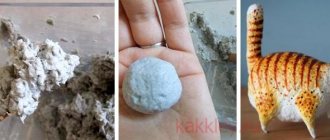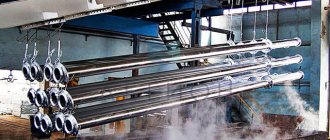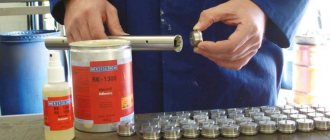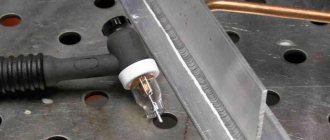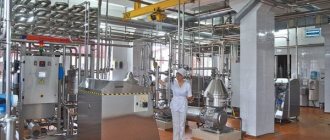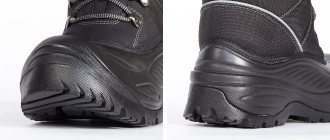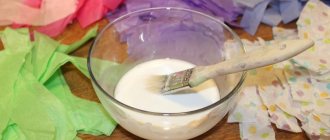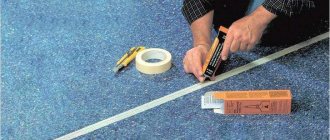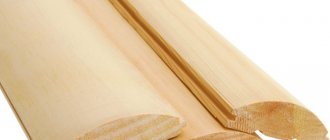The main stages of gluing concrete to various materials include identical steps that must be followed to obtain a reliable fastening.
Preparatory processes
Clean the concrete surface from dust and dirt. New surfaces do not require much preparation. Dust is removed with a damp brush. Repair involves cleaning of residual adhesive mixtures. Significant differences require additional leveling with a layer of cement mortar or plaster.
Primer
When gluing concrete to a variety of materials, concrete is primed! The adhesion of the cement surface, which was initially low, increases. There are several types of soil on the construction market:
- universal;
- deep penetration;
- specialized.
It is enough to treat a new concrete slab with a universal primer. Old concrete planes require deep penetration to bind molecular groups that have lost strength. Acrylic primers are the best choice, safe and practical. Polystyrene-based primer is highly toxic and is used only industrially.
Adhesive mixtures
A large number of adhesive compositions are produced for working with various materials. Dry, liquid, intended for specific surfaces ─ the choice is difficult. Concrete planes have a porous structure; universal mixtures are the most suitable option for gluing plastics, rubber, and plywood. If the compounds will be exposed to high humidity and temperature changes, it is better to use products containing deep-impact modifiers.
Ready-made mixtures are used; adhesive compositions are prepared immediately before starting work, strictly following the instructions indicated on the packaging:
- fill the container with water;
- Gradually pour out the dry mixture, stirring evenly to avoid lumps;
- leave to settle for ten to fifteen minutes;
- Stir thoroughly again.
Using a mixer or drill, completely immerse the rotating planes, eliminating splashing of the mixture.
Bonding procedure
Depends on the type of material and purpose of the surface. Smooth plane and tight fit are a guarantee of high-quality connection and durability of use.
Adhesive for PVC panels: which one is better
PVC panels are a popular material for redecorating premises. This circumstance can be explained by their low cost, ease of installation and variety of colors. Using this material, you can quickly and inexpensively renovate a small office, utility room, decorate the walls of a store, and the like. However, such panels are very often used for quick and practical bath renovations. This can be done with your own hands, but it is better to collect complete information about how and how to glue plastic to the wall before work.
- Description of PVC panels
- What to look for when choosing glue
- Glue for PVC panels: which one is better
- Liquid Nails
- How to glue plastic panels to the wall
Features of installing plastic panels on the ceiling
Now let's look at ways to attach plastic panels to the ceiling. Before installation, you need to determine the distance between the panels and the ceiling. This gap will depend on the type of lighting. If you plan to install built-in lamps, then the distance should be at least 10-15 cm, so you can completely hide the wiring. Mark the locations of the lamps in advance with a pencil, cut out the holes and install the lamp bases.
Metal lathing for mounting plastic panels on the ceiling in the bathroom.
Next, you perform the same steps as when installing the panels on the walls. In a room with a flat ceiling, you can do without lathing. Install the ceiling plinth on three walls before starting work. Use a building level to position the panels evenly.
When installing plastic panels in a room with high humidity, fill the ceiling gaps with silicone sealant to achieve complete waterproofness.
Installation of PVC panels can be carried out using the following methods:
- Mechanical fixation of finishing building materials to the sheathing, using staples, screws or nails. A fairly reliable method, and most importantly, very simple. This type of fastening is not recommended for apartment rooms in which large temperature changes are observed, since a PVC panel limited by a rigid fastening will not be able to expand and contract under the influence of different temperatures, and this can lead to slight warping of the coating and, as a result, its damage after a while.
- Fastening PVC panels to wooden or metal slats using clamps, which are fixed with nails, staples or self-tapping screws. This method allows the panel to change its physical dimensions due to temperature changes, since the clamp does not rigidly fix the material to the rail.
- Fastening with clamps is similar to the previous method, but on plastic slats. This installation method makes it very easy to fasten the “board” to the sheathing and also simply dismantle the entire cladding if it is necessary to move it to another room.
- Installing PVC plastic panels directly onto a concrete base using glue. This method of attaching panels requires a flat wall surface. Accordingly, before starting the installation of the base material, it is necessary to level the surface of the wall or ceiling by treating it with a cement-sand mixture, putty and primer. Despite the fact that preliminary preparation is required, it is a very simple method and, importantly, does not interfere with the dimensional fluctuations of the plastic.
- Fastening PVC panels to the sheathing slats using glue. The lathing fulfills its intended purpose, as if leveling the surface, and the PVC trim is mounted to it using glue.
Description of PVC panels
The abbreviation PVC is a short form of the word polyvinyl chloride. The term refers to ordinary plastic material, plastic that has been shaped into the desired shape during the manufacturing process. For many years, PVC panels have been actively used as a finishing material, which has many advantages.
- Long service life without changing characteristics and appearance - 10 years or more, which is an excellent indicator for a finishing material.
- Easy to maintain - the panel is easy to clean from dust, it can be washed easily with any means (except abrasives).
- Environmental friendliness - modern PVC panels are being made from safe materials.
- Moisture resistance is one of the most important characteristics, thanks to which the panels can be used for finishing bathrooms, bathrooms, and other rooms where high humidity is noted.
- Fire safety – good quality panels, made in accordance with the technology, do not burn well and are non-toxic.
- Resistance to low and high temperatures, making the material suitable for finishing rooms for various purposes.
- Excellent level of sound insulation.
- The ability to attach to various surfaces – including concrete.
A huge selection of panel colors, with various designs and patterns. Such panels are great for quick and inexpensive repairs, but you should purchase them only from trusted suppliers who guarantee high quality products. Installation can be done at home yourself.
To avoid the need to soon repair or completely redo the finish, you need to pay serious attention to the choice of glue.
Types of glue
Installing panels with special glue is a simple and inexpensive way for novice builders to complete finishing work.
Adhesive compositions for this type of finishing work must have certain properties:
- moisture resistance - for reliable fixation of the structure in rooms with high humidity;
- resistance to temperature fluctuations and ultraviolet radiation;
- elasticity;
- antiseptic properties and resistance to mold and fungi;
- economical and convenient packaging;
- high percentage of setting, transparency and adhesion;
- absence of unpleasant odor and harmful substances.
Manufacturers of adhesives indicate on the packaging what types of work and materials they are suitable for. An illiterate choice of glue or poor quality of the composition will significantly reduce the service life of the structure, lead to a change in color, structure and shedding of the fixing agent. The building materials market offers two types of glue: one-component and two-component. The first type is a ready-made solution, which is easy to apply and use. The second is a set consisting of an adhesive base and a thickener, a durable and reliable composition for professional builders.
Depending on the properties, adhesive compositions are:
- fixing – fixes elements to the working surface;
- reactive – used to work with large elements;
- contact - durable and reliable solutions;
- dispersion - glue is applied only to the surface of the base, which significantly reduces the consumption of the composition and reduces finishing time.
The most popular products on the shelves of construction stores are liquid nails, Titan brand products, Moment Montazh glue, Secunda type T cold welding (for multi-component and multi-layer surface types), polyurethane foam.
The most popular adhesive with high positive reviews is liquid nails.
It has the following universal properties:
- environmental Safety:
- waterproof composition - used for finishing bathrooms, swimming pools and kitchen splashbacks;
- consistency in the form of a paste with a transparent beige tint;
- antibacterial composition – prevents the development of mold and fungi in a warm and humid environment;
- low consumption: 50 g per 1 m2.
Rules for applying the adhesive composition:
- before starting work, it is necessary to degrease the surface with alcohol-based solutions;
- an adhesive composition based on vinyl chloride polymer is used for plastic, and thermoplastic compounds are used for attaching rubber;
- the composition must be applied in an even layer;
- the use of high temperatures will increase the percentage of setting of the structure and the working base;
- it is necessary to avoid loading on the surface for the first 24 hours.
About the surface
The surface itself must be almost perfect, so that there are no differences or other defects. Allowable curvatures should not exceed 4 mm. If the norms are exceeded, you will fail.
The surface should be prepared as follows:
First of all, the walls are primed so that all excess dust is removed from them. You can first use a vacuum cleaner to remove dust from the walls, and then cover the walls with a primer mixture.
Next, the walls need to be leveled so that the surface is vertical and there are no holes or bumps on them. The smoother your walls are, the closer the decorative panels will be to them.
Next, the walls are primed again. This is done so that the panels adhere well to the walls. This ensures good adhesion.
By and large, this is enough. On some sites you can find information that the walls need to be additionally puttied, but in our opinion this is a waste of money. If you putty on plastered walls, it won't be any worse, but it will cost you additional investment. There is an opinion that glue adheres more reliably to putty. This may be true, but if you don’t skimp on the primer and saturate the walls well with it, this will be more than enough for your PVC panels to stick well.
Useful tips
To firmly glue PVC panels, you need to strictly follow specific recommendations. It is important to remember that polyvinyl chloride is a material that does not withstand significant mechanical loads. Therefore, you should not put too much pressure on it with heavy objects.
This material does not cope well with the effects of aggressive chemicals, and therefore it should not be washed with the most concentrated detergents. To avoid mistakes, before work we advise you to study in detail how to glue PVC panels to the wall.
Source
Bonding with liquid nails
Another alternative way to glue polystyrene sheets. Suitable only for smooth concrete surfaces. The offer of liquid nails is extensive, so it is advisable to familiarize yourself with their purpose, conditions of use and operation indicated on the packaging. Compositions are created for various pairs of materials to be glued, including the pair polystyrene foam and concrete. This product is a polymer paste composition to which components have been added that improve adhesive properties.
Fastening with liquid nails.
Thanks to this, liquid nails are stronger than powder adhesives and harden even at high humidity. However, there is a significant drawback - the compounds are poisonous, so you should work with gloves. Such adhesives are packaged in oblong tubes, which are inserted into mounting “guns”. The benefits of using them include:
- the highest strength of materials connection;
- heat resistance;
- low technological consumption;
- complete hardening of the joint within 24 hours;
- frost resistance;
- efficiency and ease of installation;
- absence of odors and short setting time (from 20 to 40 minutes).
Related article: How to insulate a bathhouse inside a wall and ceiling
The latter increases the labor intensity of the work when the slabs are to be mounted on the ceiling (equipment, patience and skills are required). The composition will firmly adhere to polystyrene foam when the surface of the concrete is leveled, cleaned and dried. The substance squeezed out of the tube with a “gun” is located on the foam plastic in a small volume at several points, and not over the entire sheet area, as, for example, in the case of applying polyurethane foam. The slabs should be glued, providing pressure over the entire surface for a sufficiently long time so that the liquid nails set. Then the seams between the sheets are treated with polyurethane foam (sealant).
Features of working with different materials
Construction and repair work involves the use of different materials: plastic, metal, rubber, drywall. Insulation of premises is carried out with polystyrene foam boards. There are certain features of working with different building materials.
Plastic
Plastic panels and tiles are popular finishing materials. They cover the walls and floor with it. An adhesive connection allows for easy replacement of a deteriorated surface without dismantling the entire area. Preparation for pasting is standard. The main question is how to glue the plastic to the concrete. There are special adhesive compositions for joining plastic panels and concrete slabs. The best option is spot-on, using liquid nails. A reliable connection will be ensured by adhesive and sealant; fungicidal antifungal elements allow the composition to be used in damp rooms.
Ruberoid
Rolled material is used for installing soft roofs and waterproofing surfaces. The first condition for installation on concrete is a dry surface of the slabs! Moisture will create a repulsive layer that negatively affects the strength of the connection; it will become impossible to glue the roofing felt to the concrete. The adhesive composition necessarily includes a bitumen component. The method of applying mastic is hot or cold. The roll is rolled out onto an evenly distributed adhesive layer, pressing the surfaces tightly with metal - tape or lath, laying the roofing felt on the concrete.
Connection technology
The main stages of gluing concrete to various materials include identical steps that must be followed to obtain a reliable fastening.
Preparatory processes
Clean the concrete surface from dust and dirt. New surfaces do not require much preparation. Dust is removed with a damp brush. Repair involves cleaning of residual adhesive mixtures. Significant differences require additional leveling with a layer of cement mortar or plaster.
Primer
When gluing concrete to a variety of materials, concrete is primed! The adhesion of the cement surface, which was initially low, increases. There are several types of soil on the construction market:
- universal;
- deep penetration;
- specialized.
It is enough to treat a new concrete slab with a universal primer. Old concrete planes require deep penetration to bind molecular groups that have lost strength. Acrylic primers are the best choice, safe and practical. Polystyrene-based primer is highly toxic and is used only industrially.
Adhesive mixtures
A large number of adhesive compositions are produced for working with various materials. Dry, liquid, intended for specific surfaces ─ the choice is difficult. Concrete planes have a porous structure; universal mixtures are the most suitable option for gluing plastics, rubber, and plywood. If the compounds will be exposed to high humidity and temperature changes, it is better to use products containing deep-impact modifiers.
Ready-made mixtures are used; adhesive compositions are prepared immediately before starting work, strictly following the instructions indicated on the packaging:
- fill the container with water;
- Gradually pour out the dry mixture, stirring evenly to avoid lumps;
- leave to settle for ten to fifteen minutes;
- Stir thoroughly again.
Using a mixer or drill, completely immerse the rotating planes, eliminating splashing of the mixture.
Bonding procedure
Depends on the type of material and purpose of the surface. Smooth plane and tight fit are a guarantee of high-quality connection and durability of use.
Selection of glue
Plastic is a lightweight material, so there is a misconception that it will hold up to any composition. But for fixing PVC, especially in the bathroom, a product with increased strength and a number of special characteristics is required.
What kind of glue should be used for PVC panels:
- Firstly, it is moisture resistant. Regular glue will not withstand constant humidity. Only moisture-resistant glue will ensure long-term and reliable fixation of panels in the bathroom and similar rooms.
- The composition must withstand a wide range of temperatures and their frequent fluctuations.
- A high degree of adhesion is necessary for a strong bond.
- It would be good if the components included antibacterial additives. Due to increased humidity, a favorable environment for the growth of bacteria is formed. Good glue will prevent the spread of mold and mildew.
- UV resistance also plays a role.
- The glue should be easy to apply. It’s good when there is a special tip on the package.
- The transparency of the composition speaks in its favor.
- The faster it sets, the better. Ideally, after 10 minutes after attaching, the panel will be clearly fixed on the wall.
- The composition should not contain toxic substances; a good indicator is the absence of a pungent odor.
The quality of the selected adhesive directly affects the stability of the finishing material. The panels themselves can last up to 10, and sometimes up to 15 years. If the glue is chosen incorrectly, the shelf life of the finish will be significantly reduced.
Selecting the adhesive composition
You need to understand not only how to glue the panels, but also what to use to fasten the surfaces. Many manufacturers offer liquid nails and glue for work. It is necessary to pay attention not only to the brand, but also to the parameters of the product you are going to purchase:
- One of the main values is the moisture-resistant characteristic. They are used in rooms with high humidity levels. It is better to choose a composition that can not lose properties with a sharp change in temperature. This is important both for the bathroom and for the loggia.
- Let's not forget about good adhesion, which contributes to reliable, long-term adhesion.
- To understand exactly what material you need, pay attention to the composition of the glue. The presence of antibacterial additives significantly increases the attractiveness of the product. The treated base and corners of the panels will prevent the formation of fungus, which can have a negative impact on health.
- If you have to work on a balcony, in areas illuminated by direct rays of the sun, you need to look at the resistance of the composition to the influence of ultraviolet radiation.
- Pay attention to the application method, setting speed and performance characteristics of the product. The shorter the bonding time, the better.
- The absence of a sharp, unpleasant odor indicates a minimal concentration of harmful substances. You can safely use the adhesive in your living space.
Recommendations for adhesive fastening
Gluing the panels is quite simple if you follow some recommendations and choose the right products. The glue that is applied using a special heat gun is suitable; for example, so-called “liquid nails” interact well with PVC surfaces. The decorative coating is also perfectly attached using Moment-Montazh or Titan adhesives. In addition, polyurethane sealant has excellent adhesive properties and does not expand during use.
When choosing an adhesive, you should consider the following qualities:
- After drying it should become transparent.
- The quality of surface bonding must be high.
- The glue must be resistant to cold, humidity, alkalis, temperature changes and exposure to sunlight.
- It must have the property of durability.
- It should set in a short time.
- It must be environmentally friendly.
- The glue should not have a strong unpleasant odor; Formulations with increased toxicity should be avoided.
Products of the company Kleiberit
Among the good proven products we can highlight “Kleiberit 636”, it is safe for health, resistant to moisture, applied on one side, dries quickly. “Moment Crystal” is also perfect for decorative coating. It perfectly withstands low temperatures, moisture, has the property of transparency and quickly glues surfaces.
Procedure for gluing panels:
What to look for when choosing glue
Plastic panels should serve for a long time and please with an aesthetic appearance, which can only be achieved with the use of high-quality and suitable adhesive. When thinking about how to glue plastic panels to concrete, it is best to choose compounds specifically designed to work with this material. But there are other suitable options that will ensure sufficient reliability of fixation.
What kind of glue should be used to fix PVC panels:
- Become transparent after complete drying, so as not to be noticeable on the finish and not spoil its appearance.
- Demonstrate high resistance to moisture, sudden temperature changes, high/low temperatures.
- It is desirable that it sets quickly.
- It is important to ensure the highest possible quality of gluing.
- The glue must guarantee long-lasting fixation so that the coating does not have to be changed after a year or two.
- When considering the use of glue in a residential area, it must be safe, so toxic compounds with a strong odor are not chosen for these purposes.
- It is desirable that the glue contains antibacterial additives.
Preparation: organizing the process
Primer: a must
Acrylic primer penetrates deeply into concrete and creates a binding and filling effect, increasing surface adhesion. Before attaching other building materials to concrete using an adhesive, it is imperative to prime the intended site. Covering with soil will help increase the adhesion of reinforced concrete. Protective agents differ according to the type of impact:
- Station wagon class. It is relevant to use for newly constructed structures.
- Deep penetrating agents. The preparations contain active molecules that, penetrating into the structure of the material, create a filling and binding effect. A widely used example is acrylic-based primers.
- Special silicate-containing. Chemical representatives from the polystyrene series. Due to high toxicity, they are used only for external work and industrial facilities.
Glue: material features
Plastic, drywall and any element can be attached to a concrete surface by gluing, using construction adhesive or other adhesive forms for concrete. The technology industry offers consumers a wide range of products and various appearances. The release form is dry, liquid adhesive for concrete; a new product in the construction industry, emulsion, is widely popular. Positively interacts with rubber, plastic and wood plywood. If you need to glue the material in an environment that often comes into contact with moisture and is subject to temperature changes, it is better to give preference to modifying agents.
Fastening rules: how to do it right?
A well-organized process of fastening with an adhesive onto a concrete surface is a guarantee of the strength, longevity of the material and the quality of the work performed.
In order for the concrete surface to be as amenable to adhesive as possible and firmly connected to the contacting element, it is necessary to properly prepare the site for future stages. List of necessary manipulations:
- Carry out the procedure for cleaning the concrete surface: remove dirt stains and dust deposits.
- Dry the area thoroughly.
- Repair external defects. Treat chipped and cracked areas with a layer of finishing putty.
- Remove old building elements such as paint, loose leveling agents, worn-out protective agents.
- Dry again.
- Apply an antifungal agent to the concrete.
Types of glue liquid nails
You can install PVC panels using liquid nails glue.
- Liquid Nails 601 can bond a wide variety of materials. Designed for indoor work. The materials to be glued can be adjusted within ten minutes.
- Liquid nails 901 can be called universal. Designed for gluing durable heavy structures. Work with them can be carried out both inside and outside. It is not afraid of moisture, its strength does not depend on weather conditions. It also has a drying time of up to ten minutes, which is enough to correct incorrectly glued surfaces.
- Liquid nails 915 are designed for work in conditions of high humidity - in bathrooms, showers. It can be used to glue plastic wall panels, as it is intended for interior work. Thanks to it, a waterproof and durable connection is created.
Product examples
There are several trusted manufacturers that produce special glue for plastic:
Moment crystal
- Universal adhesive for plastic Kleiberit on synthetic resins. Sold in tubes with a convenient nozzle. It has an affordable price, but it fixes PVC well, is not afraid of moisture and dries quickly. The composition is safe.
- Glue " Moment-crystal ". Also a universal adhesive, it can attach a plastic panel to almost any base. The advantage of the composition is that it is transparent.
- Another Moment glue is liquid nails (“ Installation ”). Lives up to its name. It will firmly connect even poorly compatible materials. There are samples for both interior and exterior work.
- " Emphikol " is a special composition for working with polyvinyl chloride. Colorless, viscous, forms a strong connection between the plastic and the surface.
- MitreFix is an alternative composition that is moisture resistant. Forms a strong seam.
MitreFix
The main thing in choosing an adhesive is the mark on the packaging that the composition is suitable for working with plastic. If you are not sure of the glue’s abilities, contact a specialist consultant and read the instructions. It is recommended to buy glue only in construction departments, so as not to receive a fake or low-quality product.
